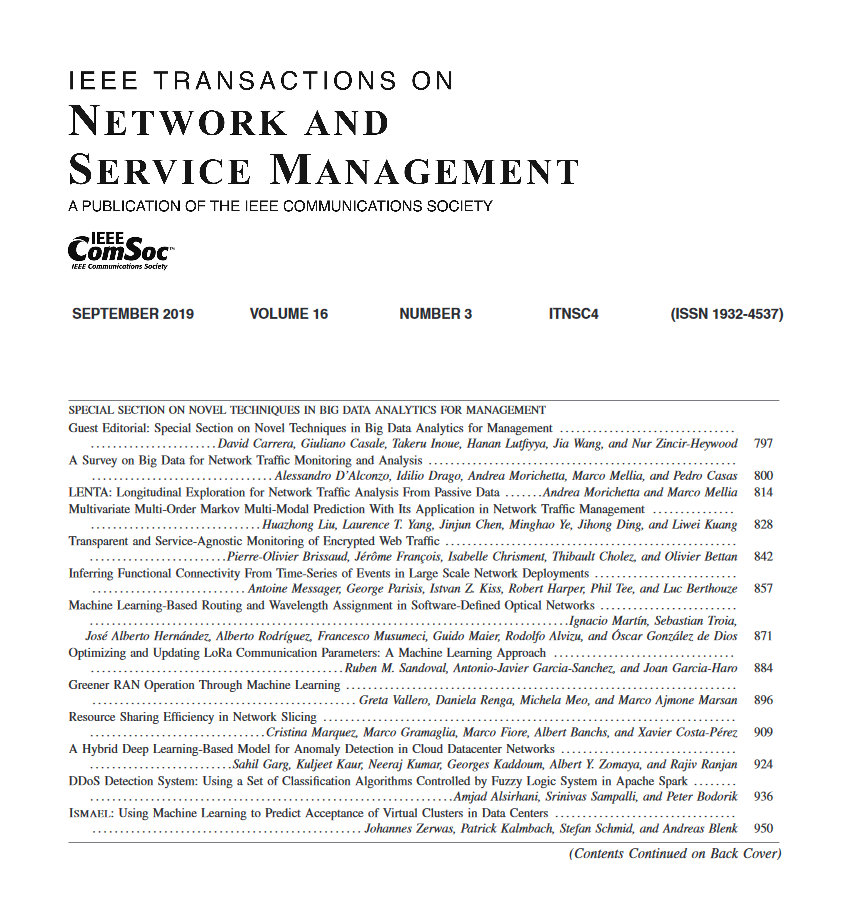Resilient Multi-Hop Autonomous UAV Networks With Extended Lifetime for Multi-Target Surveillance
IF 5.4
2区 计算机科学
Q1 COMPUTER SCIENCE, INFORMATION SYSTEMS
IEEE Transactions on Network and Service Management
Pub Date : 2025-01-13
DOI:10.1109/TNSM.2025.3528495
引用次数: 0
Abstract
Cooperative utilization of Unmanned Aerial Vehicles (UAVs) in public and military surveillance applications has attracted significant attention in recent years. Most UAVs are equipped with sensors and wireless communication equipment with limited ranges. Such limitations pose challenging problems to monitor mobile targets. This paper examines fulfilling surveillance objectives to achieve better coverage while building a resilient network between UAVs with an extended lifetime. The multiple target tracking problem is studied by including a relay UAV within the fleet whose trajectory is autonomously calculated in order to achieve a reliable connected network among all UAVs. Optimization problems are formulated for single-hop and multi-hop communications among UAVs. Three heuristic algorithms are proposed for multi-hop communications and their performances are evaluated. A hybrid algorithm, which dynamically switches between single-hop and multi-hop communications is also proposed. The effect of the time horizon considered in the optimization problem is also studied. Performance evaluation results show that the trajectories generated for the relay UAV by the hybrid algorithm can achieve network lifetimes that are within 95% of the maximum possible network lifetime which can be obtained if the entire trajectories of all targets were known a priori.面向多目标监视的弹性多跳自主无人机网络
近年来,无人机在公共和军事监视应用中的协同利用引起了人们的广泛关注。大多数无人机配备了传感器和有限范围的无线通信设备。这些限制给监测移动目标带来了挑战性问题。本文探讨了实现监视目标以实现更好的覆盖,同时在具有延长寿命的无人机之间建立弹性网络。通过在机群中加入一架中继无人机,自主计算其飞行轨迹,研究了多目标跟踪问题,以实现所有无人机之间的可靠连接网络。提出了无人机间单跳和多跳通信的优化问题。针对多跳通信提出了三种启发式算法,并对其性能进行了评价。提出了一种在单跳和多跳通信之间动态切换的混合算法。研究了优化问题中考虑的时间范围的影响。性能评估结果表明,在已知所有目标的全部轨迹的前提下,混合算法生成的中继无人机的网络寿命可以达到最大可能网络寿命的95%以内。
本文章由计算机程序翻译,如有差异,请以英文原文为准。
求助全文
约1分钟内获得全文
求助全文
来源期刊

IEEE Transactions on Network and Service Management
Computer Science-Computer Networks and Communications
CiteScore
9.30
自引率
15.10%
发文量
325
期刊介绍:
IEEE Transactions on Network and Service Management will publish (online only) peerreviewed archival quality papers that advance the state-of-the-art and practical applications of network and service management. Theoretical research contributions (presenting new concepts and techniques) and applied contributions (reporting on experiences and experiments with actual systems) will be encouraged. These transactions will focus on the key technical issues related to: Management Models, Architectures and Frameworks; Service Provisioning, Reliability and Quality Assurance; Management Functions; Enabling Technologies; Information and Communication Models; Policies; Applications and Case Studies; Emerging Technologies and Standards.
 求助内容:
求助内容: 应助结果提醒方式:
应助结果提醒方式:


